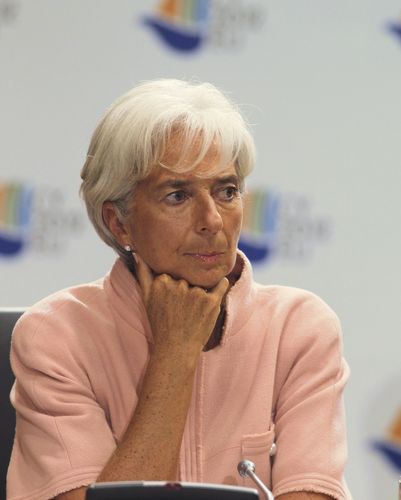The IMF is, among other issues, dealing with a US fiscal cliff, China’s slower investment and high public debt in Japan, but at the moment the eurozone is of paramount concern.
To view the Digital edition, please click here.
A few days after the press conference following the September rates decision meeting at the European Central Bank in Frankfurt, International Monetary Fund managing director Christine Lagarde publicly backed the ECB’s new attempt to regain the upper hand in the eurozone debt crisis with unlimited bond purchases.
“What the central bank announced last Thursday [September 6] is a clear indication of the framework in which it would be an active player in restoring the situation,” she said. “Our sense is that now the euro partners know exactly what they have to do. As far as the IMF is concerned, we shall certainly be ready to help and to assist in the design and monitoring of eventual programmes.”
There was an almost visible sense of relief throughout the eurozone at Lagarde’s approval. Italian Finance Minister Vittorio Grilli called her comments “positive” while the normally unflappable ECB executive board member Joerg Asmussen said: “As an external policeman, the IMF has a lot of leverage”.
It is a sign of how far the IMF has travelled. In more recent memory its successes have been in emerging markets. Programmes such as those in former Yugoslavia and in Latin America have justifiably received plaudits, but in those regions it had the advantage of working broadly without much political interference. Now its attention is on the euro – a much larger and more complex beast to manage.
Although the IMF has no direct role in regulating financial institutions, its views and advice often provoke intense debate among governments and central banks. And, as seen, there is relief when it approves. Throughout the eurozone crisis the IMF has been clear about what it thought was needed. At the beginning of August, the organisation called for a “policy game changer” to stop the spread of the region’s debt crisis.
“Despite progress in the face of constraints, the sense is that not enough has been done to stop the spread of stresses and attenuate fiscal growth-banking feedback loops,” the IMF warned.
Like most other forecasts, the IMF’s own view on Europe has been gloomy – close to zero growth in core Europe and decline in peripheral Europe. “In Europe we are observing an increasing divergence between core and periphery countries,” said Olivier Blanchard, economic counsellor and director of the research department of the IMF.
“Periphery euro countries face difficult adjustment. Fiscal consolidation is needed, but it’s weighing heavily on growth. Structural reforms will bear fruit, but only in the future. Banks have to deal not only with bad legacy loans but also with increasing non-performing loans, which themselves reflect the depressed state of the economy. High debt burdens are making borrowing expensive for the sovereigns. The result is negative growth, not only for this year but also for next – both for Italy and for Spain,”
New pledges
The question of what the IMF can do remains pertinent. Towards the end of April this year Lagarde scraped together pledges for US$430bn in new funding for the organisation. That included commitments of more than US$350bn mostly from rich countries, alongside unspecified pledges from large emerging markets such as Brazil, China, and India. The US and Canada declined to put their hands in their pockets. This gives the IMF a war chest of almost US$1trn in lending capacity.
Is that enough? Probably not, but that misses the point. The IMF is almost inconsequentially small relative to the size of the global trade flows it was originally conceived to help manage. It is worth remembering that when it was set up at the Bretton Woods Conference in 1944, its war chest represented around 10% of those trade flows. But the IMF’s role has changed – from balance of payment problems to capital movements and, more to the point, crisis prevention and crisis resolution. It is the two final roles that it has grasped with both hands.
And it is with the eurozone crisis that its crisis management role has been most visible. It was an active part of the troika, along with the European Commission and European Central Bank, looking at dealing with Greece, but it goes deeper than looking at one country. It is indicative that this summer’s roundtable organised by the IMF’s Monetary and Capital Markets Department, was called “Asset Allocation Challenges in Turbulent Times”.
Vicious cycle
At the opening session in Washington in June, Jose Vinals, director of the IMF’s monetary and capital markets department, emphasised “the potential for a vicious cycle between high sovereign debt, slow growth, and bank balance sheet stress”.
Vinals went on to stress the challenges that reserve managers face with respect to the shrinking pool of safe assets, the increasing significance of currency diversification, the completion and implementation of regulatory reforms, and the increasing coordination among reserve managers.
It is precisely that vicious cycle that ECB president Mario Draghi has been trying to break and his attempts to do so have been met with some approval. At the annual central bank symposium in Jackson Hole, Wyoming, IMF first deputy managing director David Lipton followed up on Lagarde’s comments with: “Markets have been comforted by what was decided this summer by the heads [of government] and more recently by what was announced by President Draghi and spreads have come down”. But he went on to add: “It is important that Europe puts one foot in front of the other and starts carrying out the things that they have decided.”
The eurozone clearly weighs heavily, but although it is the largest concern for the IMF, it is not the only one. The IMF is also grappling with the US fiscal cliff which is likely to hit in 2013, as a result of tax cuts worth US$4trn expiring and automatic government spending reductions next year. Further adding to the global worries, China’s slower investment is likely to hit trade partners and world prices and high public debt in Japan is making it permanently vulnerable to shifts in market sentiments.
As if this were not enough, IMF research warned that credit costs are likely to increase. In a September study that examined the impact of global financial reform – predominantly Basel III and derivative market reforms – on credit pricing, the IMF concluded that average bank lending rates are likely to rise 26bp in the US, 17bp in Europe and 8bp in Japan over the long term.
For the short to medium term, though, Europe remains in the spotlight. Even aside from the doom and gloom from the baseline forecasts, what preys on the IMF’s mind is the increase in downside risks. “It is that vicious cycles in Spain and Italy become stronger – that output falls even more than it does, that one of these countries loses financial access to markets. And the implications of such an event could easily derail the world recovery,” said Blanchard.
The potential knock-on effects of that that would have real significance. “The crisis still has a long way to go before it ends and it is key that Europe retains its faith in the single currency … The growth side [of the eurozone crisis] has a profound impact on the global economy,” said IMF deputy managing director Zhu Min in early September before warning that a further deterioration in Europe could knock as much as 1.5%–2.0% off economic activity in the US and Japan and 1% from activity in China.

